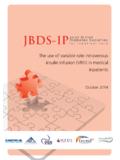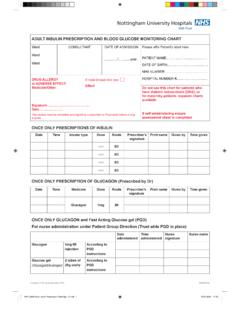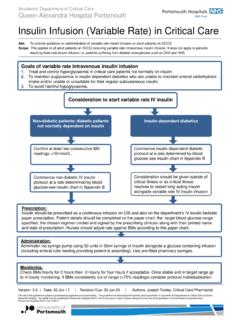Transcription of 5% GLUCOSE INTRAVENOUS INFUSION In AVIVA …
1 GLUCOSE INTRAVENOUS INFUSION ( AVIVA bag) Product Information 5% GLUCOSE INTRAVENOUS INFUSION . In AVIVA Plastic Container NAME OF THE MEDICINE. Composition The active ingredient is GLUCOSE (anhydrous) in Water for Injections. Chemical structure/ Molecular formula The chemical name of GLUCOSE is (+)-D- glucopyranose. Molecular formula of GLUCOSE is ;. Molecular Weight = CAS: 50-99-7. DESCRIPTION. GLUCOSE is a monosaccharide, having physical characteristics as a white or almost white, crystalline powder, freely soluble in water, sparingly soluble in ethanol (96 per cent). The GLUCOSE INTRAVENOUS Infusions are clear, colourless solutions, practically free from visible particles and are sterile, non-pyrogenic parenteral solutions. The concentrations of GLUCOSE dissolved in a litre of Water for Injections are shown in Table 1 (see Presentation and Storage Conditions).
2 They do not contain an antimicrobial agent or added buffer and have a ph of - for 5% GLUCOSE concentrations. The isotonicity of these preparations is shown in Table 1 (Presentation and Storage Conditions). The GLUCOSE 5% INTRAVENOUS INFUSION is an isotonic solution. PHARMACOLOGY. Mechanism of Action GLUCOSE is readily metabolised into carbon dioxide and water, with a release of energy. As such, an administration of a GLUCOSE solution either by oral or parenteral route provides water for body hydration as well as calories. In addition, it may reduce catabolic loss of nitrogen from the body and aids in prevention of depletion of liver glycogen. That is, in the absence of GLUCOSE , amino acids undergo deamination. It is followed by oxidation, with a release of energy. Thus, the GLUCOSE INTRAVENOUS Infusions has value as a source of water and energy. GLUCOSE is readily converted into fat in the body which can be used as a source of energy as required.
3 Under a similar conversion into storage of energy, GLUCOSE is stored in the liver and muscles as glycogen. For a quick rise in plasma GLUCOSE , glycogen is readily converted into GLUCOSE . 5% GLUCOSE INTRAVENOUS INFUSION AVIVA (ccsi43020131101) 27 May 2014 Page 1 of 9. Baxter Healthcare GLUCOSE INTRAVENOUS INFUSION ( AVIVA bag) Product Information Pharmacokinetics A GLUCOSE preparation administered by the oral route is rapidly absorbed from the gastro-intestinal tract by an active mechanism. Following an oral administration in hypoglycaemic individuals plasma GLUCOSE is built up within 10 20 minutes and peaks at about 40 minutes. As the GLUCOSE INTRAVENOUS INFUSION preparations are directly administered to the systemic circulation by INFUSION , the bioavailability of the active components is complete (100%). INDICATIONS. GLUCOSE (5%) INTRAVENOUS Infusions are mainly indicated: Whenever non-electrolyte fluid replacement is required.
4 As a vehicle for drug delivery, provided that the added components are compatible with GLUCOSE . CONTRAINDICATIONS. GLUCOSE 5% INFUSION is contraindicated in patients with: Known hypersensitivity to the product Known allergy to corn or corn products, because cornstarch is used as raw material for GLUCOSE productions Clinically significant hyperglycaemia. Avoid use after an ischaemic stroke episode or head trauma within 24h, as the induced lactic acidosis aggravates the recovery of the damaged brain tissue, with blood GLUCOSE concentrations also being closely monitored during intracranial hypertension. PRECAUTIONS. General The safety of the AVIVA plastic container used in the GLUCOSE INTRAVENOUS INFUSION preparations has been confirmed in tests with animals according to USP biological tests for plastic containers, as well as by tissue culture toxicity studies.
5 Nevertheless, care should be exercised regarding a possible incompatibility outcome resulting either from the interaction between the plastic container or active ingredients and the added therapeutic substances (see also Dosage and Administration). The introduction of additives to any solution, regardless of type of container, requires special attention to assure that no incompatibilities results. While some incompatibilities are readily observed, one must be aware that subtle physical, chemical and pharmacological incompatibilities can occur. The medical literature, the package insert and other available sources of information should be reviewed for thorough understanding of possible of incompatibility problems. In particular, the product information document of any added medication should be checked for any incompatibility with the GLUCOSE INFUSION . Do not administer GLUCOSE INTRAVENOUS infusions unless clear and the seals intact.
6 In a dilute condition, osmolarity/L is approximately the same as osmolality/kg. 5% GLUCOSE INTRAVENOUS INFUSION AVIVA (ccsi43020131101) 27 May 2014 Page 2 of 9. Baxter Healthcare GLUCOSE INTRAVENOUS INFUSION ( AVIVA bag) Product Information Hypersensitivity Reactions Hypersensitivity/ INFUSION reactions, including anaphylactic/anaphylactoid reactions, have been reported with GLUCOSE INTRAVENOUS infusions. The INFUSION must be stopped immediately if any signs or symptoms of a suspected hypersensitivity reaction develop. Appropriate therapeutic countermeasures must be instituted as clinically indicated. Dilution and other effects on serum electrolytes The administration of GLUCOSE INTRAVENOUS INFUSION can cause fluid and/or solute overloading resulting in dilution of the serum electrolyte concentrations, over-hydration, congested states, or pulmonary oedema. The risk of dilution states is inversely proportional to the electrolyte concentrations of the injection.
7 The risk of solute overload causing congested states with peripheral and pulmonary oedema is directly proportional to the electrolyte concentrations of the injection. Depending on the volume and rate of INFUSION and depending on a patient's underlying clinical condition and capability to metabolise GLUCOSE , INTRAVENOUS administration of GLUCOSE can cause: Hyperosmolality, osmotic diuresis and dehydration Hypoosmolality Electrolyte disturbances such as - Hyponatraemia (see below), - Hypokalaemia, - Hypophosphataemia, - Hypomagnesaemia, - Overhydration/hypervolaemia and, for example, congested states, including pulmonary congestion and oedema. The above effects do not only result from the administration of electrolyte-free fluid but also from GLUCOSE administration. In addition: An increase in serum GLUCOSE concentration is associated with an increase in serum osmolality.
8 Osmotic diuresis associated with hyperglycaemia can result in or contribute to the development of dehydration and in electrolyte losses. Hyperglycaemia also causes a transcellular shift of water, leading to a decrease in extracellular sodium concentrations and hyponatraemia. Since GLUCOSE is metabolised, INFUSION of the GLUCOSE solution corresponds to increasing the body's load of free water, possibly leading to hypoosmotic hyponatraemia. Hypoosmotic hyponatraemia can lead to headache, nausea, seizures, lethargy, coma, cerebral oedema, and death. Acute symptomatic hyponatraemic encephalopathy is considered a medical emergency. The risk for developing hypoosmotic hyponatraemia is increased, for example, In children In elderly patients In women Postoperatively In persons with psychogenic polydipsia The risk for developing encephalopathy as a complication of hypoosmotic hyponatraemia is increased, for example, In paediatric patients ( 16 years of age).
9 In women (in particular, premenopausal women). In patients with hypoxemia In patients with underlying central nervous system disease. 5% GLUCOSE INTRAVENOUS INFUSION AVIVA (ccsi43020131101) 27 May 2014 Page 3 of 9. Baxter Healthcare GLUCOSE INTRAVENOUS INFUSION ( AVIVA bag) Product Information Clinical evaluation and periodic laboratory determinations are necessary to monitor changes in fluid balance, electrolyte concentrations, and acid base balance during prolonged parenteral therapy or whenever the condition of the patients warrants such evaluation. Particular caution is advised in patients at increased risk of and from water and electrolyte disturbances that could be aggravated by increased free water load. Hyperglycaemia or possibly required insulin administration (see Hyperglycaemia). Preventive and corrective measures must be instituted as clinically indicated.
10 Hyperglycaemia Rapid administration of GLUCOSE solutions may produce substantial hyperglycaemia and a hyperosmolar syndrome. In order to avoid hyperglycaemia the INFUSION rate should not exceed the patient's ability to utilise GLUCOSE . To reduce the risk of hyperglycaemia-associated complications, the INFUSION rate must be adjusted and/or insulin administered if blood GLUCOSE levels exceed levels considered acceptable for the individual patient. INTRAVENOUS GLUCOSE solution should be administered with caution in patients with, for example: Impaired GLUCOSE tolerance (such as in diabetes mellitus, renal impairment, or in the presence of sepsis, trauma, or shock), Severe malnutrition (risk of precipitating a refeeding syndrome), Water and electrolyte disturbances that could be aggravated by increased GLUCOSE and/or free water load. Thiamine diphosphate, cocarboxylase, is an essential co-enzyme in the carbohydrate metabolism; therefore, patients having thiamine deficiency ( , in patients with chronic alcoholism [risk of severe lactic acidosis due to impaired oxidative metabolisation of pyruvate]) should be treated cautiously with GLUCOSE INTRAVENOUS INFUSION .
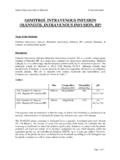
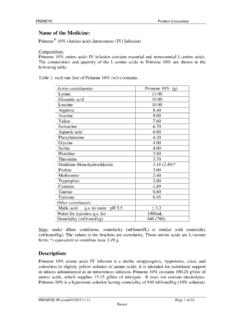
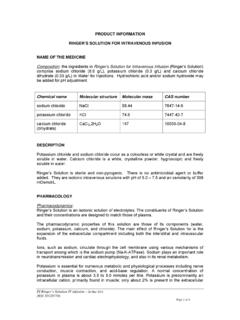
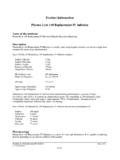
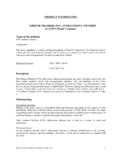
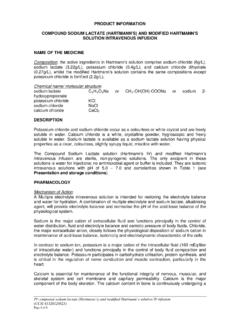
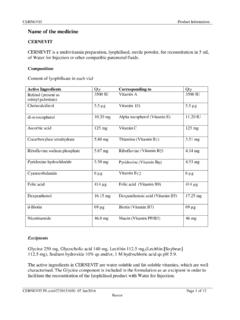
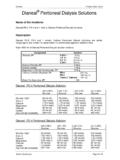
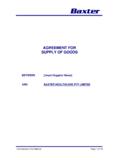
![T I S S E E L [Fibrin Sealant] - Baxter Healthcare](/cache/preview/5/e/c/8/3/b/b/2/thumb-5ec83bb2d349410260af6c556ae67fe3.jpg)
